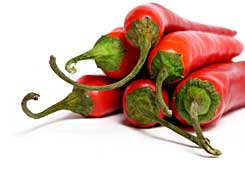 |
A Hot Sauce Guide Takes A Stand Against Bland!
|
 |
|
HOT SAUCE 101 Torrid Times Heat & Health How Hot Is Hot? The Big Chill Hall of Flame Global Warming Chile Peppers |
||
Growing Peppers By Eric Vinje, Planet Natural  Vegetable gardeners are growing peppers at an astonishing rate. Currently, they are second in popularity only to tomatoes and why not? They are prolific producers, come in all shapes, colors and sizes and range in taste from sweet to downright fiery. Peppers, including ornamental varieties, are members of the solanaceae family. Vegetable gardeners are growing peppers at an astonishing rate. Currently, they are second in popularity only to tomatoes and why not? They are prolific producers, come in all shapes, colors and sizes and range in taste from sweet to downright fiery. Peppers, including ornamental varieties, are members of the solanaceae family.Site Preparation: Most peppers are annual plants, lasting only one season. They require full sun, fast draining soil and regular water. Peppers grow best when temperatures are warm and need substantial heat to set fruit. They tolerate drought, but do best in soil that is evenly moist but not soggy. Prior to planting, mix plenty of compost into your garden area. Note: These popular garden vegetables do well in moist, not wet, soils. Drip irrigation or soaker hoses can be used to direct water right to the plants' roots. This will also keep the leaves dry, which helps prevent many fungal diseases. How to Plant: Peppers should be planted after the soil has warmed in the spring, or in a greenhouse. The night time temperature must remain above 55 degrees F. In traditional rows, space peppers 1-1/2 feet apart. Or grow them in raised beds, with 1-1/2 feet between plants in all directions. Provide support for varieties that grow over a foot tall. Apply a balanced all-purpose fertilizer once or twice after the plants become established, before blossoms set. Side-dressings of kelp can help offset potassium deficiency, and bone meal can supply needed phosphorous and calcium. Tip: In northern climates use Wall O' Waters to protect transplants from frost and speed production. Harvesting: Harvest peppers early and often - the more you pick, the more the plants will produce. Most varieties can be eaten when they are green and under-ripe, although the flavor improves as they mature. Always cut (don't pull) peppers from the plant. Allow 65 to 80 days from transplant to harvest. Tip: Once the fruit has set and colored, you can bring peppers indoors as ornamental plants. They look quite jolly for the holiday season. Don't expect them to last too long indoors. Insects and Diseases: Peppers are susceptible to many insect pests, including aphids, cutworm, leafminer and flea beetles, which chew many tiny holes in the leaves of your plants. Common plant diseases include anthracnose, bacterial spot, mosaic and blossom end rot. Seed Saving Instructions: Peppers will cross-pollinate, so separate by at least 500 feet or plant in insect proof cages covered with window screen. Select peppers that are ripe, fully colored and show no signs of disease to save for seed. Remove seeds off the core and onto a paper plate to dry. |
||
|
A division of Sparky Boy Enterprises Copyright © 2006. All rights reserved. |
||